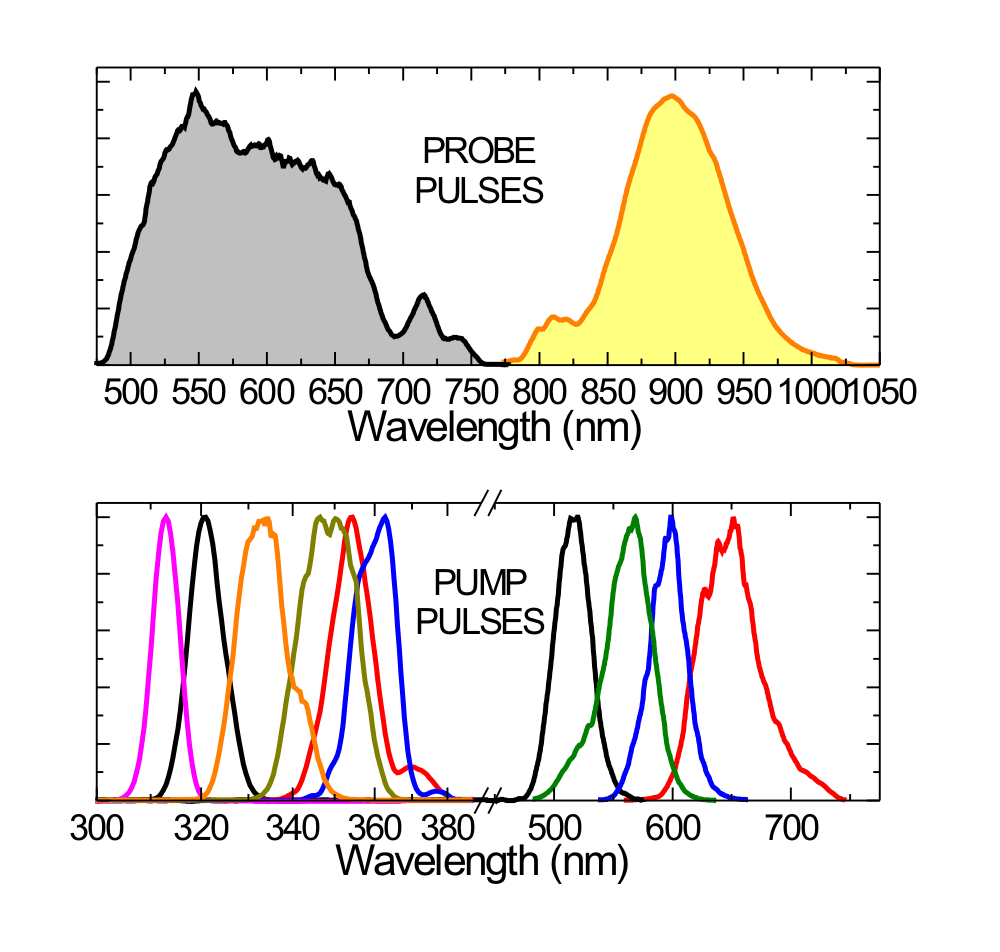This activity is devoted to the generation of tuneable high-energy few-optical-cycle pulse to be used for pump–probe spectroscopy. Our set-ups are based on different synchronized Optical Parametric Amplifiers (OPAs).
The OPA process provides an optical amplifier with continuously variable carrier frequency and represents an easy way to tune over a broad range the frequency of an otherwise fixed femtosecond laser system. If suitably designed, an OPA can satisfy the phase-matching condition over a very broad frequency range and can thus efficiently transfer the pump pulse energy to a broadband signal pulse. OPAs can therefore be used to generate broadly tunable pulses with very short duration, approaching the limit set by the period of the carrier wave.
The building blocks of an OPA are the seed generation stage and the optical amplifier. A typical setup for a broadband OPA is shown in Fig. 1. It is pumped by an amplified Ti:sapphire laser, either directly by the fundamental frequency (FF) or by the second harmonic (SH). A fraction of the beam is split and used to produce the broad band seed beam by third order nonlinear process such as white light continuum (WLC) generation, typically in a sapphire plate. Then, the high intensity pump pulse (at frequency ωp ) and the lower intensity seed (the signal, at frequency ωs ), after their timing has been adjusted by a delay line, interact in a second-order non linear crystal (such as BBO). Here, the seed is amplified and a third beam (the idler, at frequency ωi = ωp − ωs ) is simultaneously generated. Finally, a pulse compressor is used to cancel spectral phase distortions of the amplified pulse and achieve nearly transform-limited (TL) pulse duration.
In order to generate few-optical-cycle pulses the amplification bandwidth must be as large as possible. The parametric gain bandwidth is inversely proportional to the group-velocity mismatch (GVM) between signal and idler pulses. There are two basic schemes that can be used in order to reduce the GVM and thus generate broadband pulses: the degenerate OPA (DOPA) configuration in which signal and idler have the same frequency, polarization and direction (collinear interaction geometry), and the non-collinear OPA (NOPA), in which pump and signal wave-vectors propagate along different directions. In the latter case broadband phase matching can be achieved for a signal-idler angle such that the signal group velocity equals the projection of the idler group velocity along the signal direction.
 In our laboratories we have developed a series of OPAs with different configurations, enabling to tune the pulse duration and the carrier frequency from the UV to the visible to the near- and mid-infrared wavelength regions.
In our laboratories we have developed a series of OPAs with different configurations, enabling to tune the pulse duration and the carrier frequency from the UV to the visible to the near- and mid-infrared wavelength regions.
Want to read more? Have a look at these papers:
- Manzoni, C., Polli, D., Cerullo, G. “Two-color pump-probe system broadly tunable over the visible and the near infrared with sub-30 fs temporal resolution” (2006) Review of Scientific Instruments, 77 (2) Article Number: 023103
- Zavelani-Rossi, M., Polli, D., Cerullo, G., De Silvestri, S., Gallmann, L., Steinmeyer, G., Keller, U. “Few-optical-cycle laser pulses by OPA: Broadband chirped mirror compression and SPIDER characterization” (2002) Applied Physics B: Lasers and Optics, 74 (SUPPL.), pp. S245-S251.
- Tzankov, P., Zheng, J., Mero, M., Polli, D., Manzoni, C., Cerullo, G. “300 μJ noncollinear optical parametric amplifier in the visible at 1 kHz repetition rate” (2006) Optics Letters, 31 (24), pp. 3629-3631.
- Cerullo, G., Manzoni, C., Lüer, L., Polli, D. “Time-resolved methods in biophysics. 4. Broadband pump-probe spectroscopy system with sub-20 fs temporal resolution for the study of energy transfer processes in photosynthesis” (2007) Photochemical and Photobiological Sciences, 6 (2), pp. 135-144.
- Manzoni, C., Polli, D., Cirmi, G., Brida, D., De Silvestri, S., Cerullo, G. “Tunable few-optical-cycle pulses with passive carrier-envelope phase stabilization from an optical parametric amplifier” (2007) Applied Physics Letters, 90 (17), art. no. 171111
- Polli, D., Lüer, L., Cerullo, G. “High-time-resolution pump-probe system with broadband detection for the study of time-domain vibrational dynamics” (2007) Review of Scientific Instruments, 78 (10), art. no. 103108
- Polli, D., Antognazza, M.R., Brida, D., Lanzani, G., Cerullo, G., De Silvestri, S. “Broadband pump-probe spectroscopy with sub-10-fs resolution for probing ultrafast internal conversion and coherent phonons in carotenoids” (2008) Chemical Physics, 350 (1-3), pp. 45-55.

